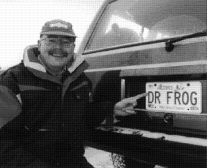


|

Research on pain, our gain |

Dr. Peter Smith, alias "Dr. Frog" |
Pain is something we'd all like to avoid. Pharmacology professor Peter Smith hopes to help us do that. He's spending much of his Killam professorship year continuing the search for an understanding of pain in relation to nerve injury. "The practical application of about 70 per cent of my research," says Smith, "is the management of nerve injury."
Smith's research focuses on the autonomic nervous system-the body's control system. "If you were a computer, it would be DOS or Windows 95," he says. "The autonomic nervous system is what makes your face turn red if you are embarrassed, your heart beat faster when you exercise, or makes you sleepy after a big meal."
But, unlike a computer, the autonomic nervous system is not "hard wired." It can change. Nerve fibres can grow under certain conditions. For example, when nerves are injured, new nerve fibres can sprout and make contact with nerves that control sensory information. When this happens, people may feel tingling, burning sensations or pain.
For 25 years, research from Smith's laboratory has contributed to the understanding of the autonomic nervous system. He was the first to use quantitative biophysical methods to analyze the effects of injury on the electrical activity of peripheral neurons. His findings have provided a better understanding of how the autonomic nervous system affects transmission of messages from sensory nerves. In turn, this has shed light on the understanding of pain resulting from peripheral nerve injury. These kinds of injuries commonly result from car accidents, or surgery.
Smith also discovered that drugs affect damaged nerves very differently from healthy nerves. Morphine, commonly used to treat chronic pain, doesn't work well with nerve injury, he says. "One treatment for serious pain is to inject drugs into the spinal cord," says Smith. "But rather little is known about how those drugs work. One technique we are developing is to do detailed analyses of nerve cells in the spinal cord and how painkilling drugs affect them. Little has been done in this area because it's technically extremely difficult." His team will pursue studies in this area during the coming year.
Smith, who has been at the University of Alberta since 1980, has presented his findings in invited lectures at 35 different institutions around the world. The Medical Research Council of Canada (MRC) supports his research consistently and ranked his latest grant application #1 out of 37.
As pharmacology's graduate program coordinator for eight years (1988-96), Smith emphasized recruiting high quality students and involving them in decisions concerning their program. This year, in addition to teaching several graduate courses, he enjoys having the opportunity to spend more time with undergraduate students. And he is particularly gratified by an increasing interest shown by clinical departments in collaboration.
A prolific author with articles in many refereed journals, Smith is currently co-authoring a book about the autonomic nervous system.
In his spare time, Smith may be found camping, skiing, or volunteering with his son or daughter's Scout group. If you attended last summer's Fringe Festival, you may have caught him playing bass guitar with one of the shows.
And the license plate "Dr. Frog"? It was a gift several years ago in honor of the thousands of hours Smith spent in his early research using frogs.
![[Folio]](http://www.ualberta.ca/~publicas/folio/gif/small/folio.gif)
Folio front page |
![[Office of Public Affairs]](http://www.ualberta.ca/~publicas/gif/small/opahome.gif)
Office of Public Affairs |
![[University of Alberta]](http://www.ualberta.ca/~publicas/gif/small/uahome.gif)
University of Alberta |